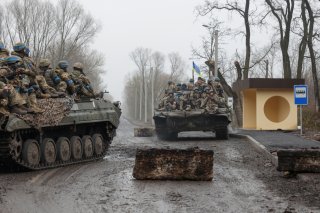Make or Break: Battle for the Donbas May Decide the Russo-Ukrainian War
The looming battle for the Donbas region will prove crucial to the course of the Russo-Ukrainian war, U.S. officials say.
In what is increasingly resembling a scene from the Eastern Front in World War II, the Russian military is seeking to encircle large groupings of Ukrainian troops in the Donbas—with one such “pocket” reportedly containing as many as 50,000 soldiers—through a maneuver called a double envelopment. This stage of the war will be fought on flat, open terrain, lending itself to Russia’s strength of mustering large numbers of mechanized infantry formations supported by vast amounts of artillery firepower. The fighting will take place in close proximity to Russia’s borders and to the separatist Russian-aligned Donetsk and Luhansk People’s Republics, providing the Russians with shorter and better-secured supply lines than in the war’s shuttered northern theater.
“I think it’s accurate that the next several weeks will be very, very critical … for the outcome of this battle that’s shaping up,” said Joint Chiefs of Staff Chairman Gen. Mark A. Milley in a meeting with European commanders, according to the Washington Post.
Swathes of the Donbas region are saturated with Russian surface-to-air missile (SAM) systems, reinforcing Western defense officials in their belief that providing Ukrainian forces with crewed, fixed-wing aircraft will not enhance their prospects, despite continued pleas for such hardware by top Ukrainian officials.
If the invading Russian forces can neutralize the bulk of Ukrainian resistance in the east, there will be little to stop them from striking out in the direction of the strategic southwestern port hub of Odesa by way of Mykolaiv. Control over Odesa, in turn, would give Moscow the opportunity to connect Russia’s mainland to the Moldovan, pro-Russian breakaway region of Transnistria. “Control over the south of Ukraine is another way out to Transnistria, where there are also facts of oppression of the Russian-speaking population,” said Rustam Minnekaev, acting commander of Russia’s Central Military District. Though it is unclear whether Minnikaev’s statement reflects the Russian military’s current established war aims, there is circumstantial evidence to suggest that the Kremlin has been entertaining the possibility of absorbing Transnistria since the war’s opening stages. Achieving victory in the Donbas would put Russian forces in a position to reopen the war’s northern theater, possibly putting renewed pressure on the capital city of Kyiv.
The West has been rushing Howitzers, tanks, and other heavy equipment to Ukraine in anticipation of the Donbas offensive, but it remains to be seen whether these continued arms shipments—buttressed by a diplomatic maximum pressure campaign against Moscow—will be enough to offset the Russian military’s underlying logistical and battlefield advantages as the fighting rages in Ukraine’s east.
Mark Episkopos is a national security reporter for the National Interest.
Image: Reuters.

